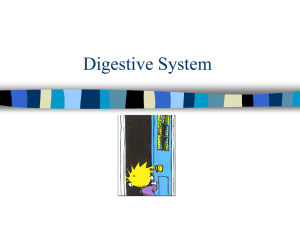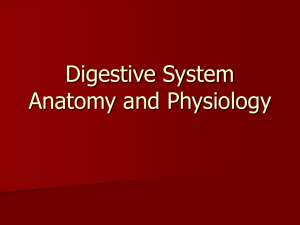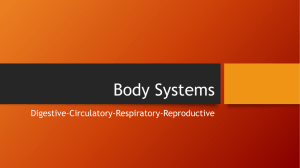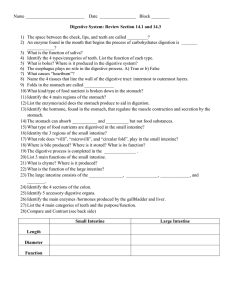Digestive System
advertisement
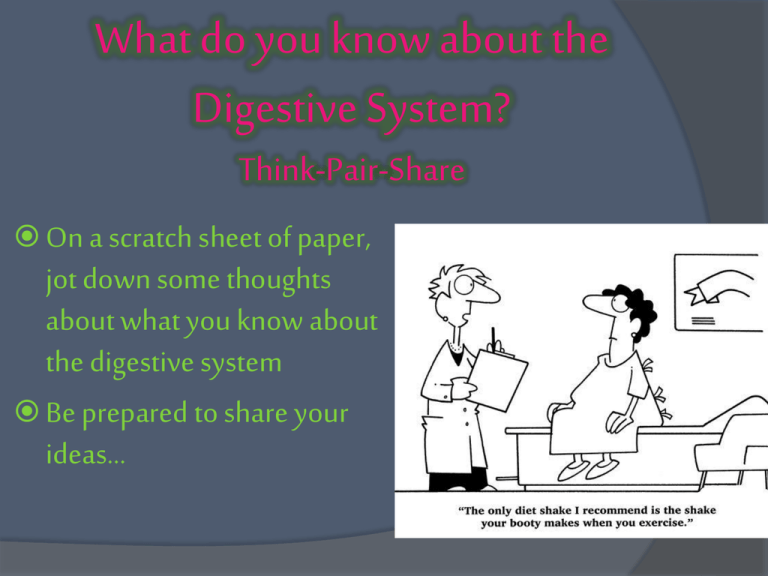
What do you know about the Digestive System? Think-Pair-Share On a scratch sheet of paper, jot down some thoughts about what you know about the digestive system Be prepared to share your ideas… Chapter 14 Course of Study 10.) Identify structures and functions of the digestive system. Tracing the pathway of digestion from the mouth to the anus using diagrams Identifying disorders affecting the digestive system Examples: ulcers, Crohn's disease, diverticulitis Next Slide…(Picture in your Notes) Be prepared to explain this step by step on the test! Anatomy of the Digestive System AKA: Gastrointestinal (GI) Tract Performs the whole menu of digestive functions (ingests, digests, absorbs, & defecates) Is a continuous, coiled, hollow, muscular tube that winds through the ventral body cavity and is open at both ends Organs include: mouth, pharynx, esophagus, stomach, small intestine, & large intestine In a cadaver, the alimentary canal is approximately 9m long, but in a living person, it is considerably shorter because of its relatively constant muscle tone Food material within this tube is technically outside the body, because it has contact only with cells lining the tract and the tube is open to the external environment at both ends. Alimentary Canal Includes teeth, tongue, & several large digestive glands Assist the process of digestive breakdown Accessory Digestive Organs Mouth Food enters the digestive tract through the mouth or “oral cavity” Mucous membrane-lined cavity As food enters the mouth, it is mixed with saliva and masticated (chewed) The cheeks and closed lips hold the food between the teeth during chewing and the tongue continually mixes food with saliva and initiates swallowing. Thus, the breakdown of food has begun before it even leaves the mouth! Also, as you already know, the papillae containing taste buds on the tongue surface allow us to enjoy and appreciate food as it is eaten….thank goodness Mouth Parts include: Lips(labia): protect its anterior opening Cheeks: Form its lateral walls Hard Palate: forms its anterior roof Soft Palate: forms its posterior roof Uvula: Fleshy fingerlike projection of the soft palate Tongue: Occupies the floor of the mouth…has bony attachments like the hyoid bone and the styloid process in the skull Lingual frenulum: secures the tongue to the floor of the mouth and limits its movements (short frenulum=tongue tied in children…gets cut) Tonsils: part of the body’s defense system Pharynx Subdivided into the: 1. 2. 3. Nasopharynx: Part of the respiratory passageway Oropharynx: Posterior to the oral cavity Laryngopharynx: Continuous with the esophagus below Walls of the pharynx contain to skeletal muscle layers The cells of the inner layer run longitudinally The cells of the outer layer run around the wall in a circular fashion Alternating contractions of these two muscle layers propel food through the pharynx into the esophagus below This propelling mechanism is called Esophagus “Gullet” Runs from the pharynx through the diaphragm to the stomach About 25 cm (10in) long It is essentially a passageway that conducts food by to the stomach Stomach C-shaped On the left side of the abdominal cavity nearly hidden by the liver and the diaphragm 25cm (10in) long, but its diameter depends on how much food it contains When it is full, it can hold about 4 liters (1 gallon) of food…when it is empty, it collapses inward on itself Acts as a temporary “storage tank” for food as well as a site for food breakdown Stomach Physical Breakdown: Chemical Breakdown: Besides the longitudinal and circular muscle layers, its wall contains a third obliquely arranged later in the muscularis external…this arrangement allows the stomach not only to move food along the tract, but also to churn, mix and pummel the food, physically breaking it down to smaller fragments Chemical breakdown of proteins begins in the stomach, a few ways: ○ The mucosa of the stomach produces large amounts of mucus ○ The lining of the stomach is dotted with millions of deep gastric pits, which lead into gastric glands that secrete the solution called “gastric juices” Chief cells produce protein- digesting enzymes, mostly pepsinogens, and parietal cells produce corrosive hydrochloric acid After food has been processed in the stomach, it resembles heavy cream and is called “chyme” Chyme enters the small intestine through the pyloric sphincter The body’s major digestive organ Within its twisted passageways, usable food is finally prepared for its journey into the cells of the body It is the longest section of the alimentary tube, with an average length of 2.5-7meters (8-18 feet) in a living person Except for the initial part of the small intestine, the small intestine hangs in sausage-like coils in the abdominal cavity Has 3 subdivision: Duodenum 5% of length Jejunum 40% of length Ileum 60% of length The small intestine is able to process only a small amount of food at one time The pyloric sphincter (literally “gatekeeper”) controls food movement into the small intestine from the stomach and prevents the small intestine from being overwhelmed Chemical Digestion in the Small Intestine The duodenum has interesting features Some enzymes are produced by the intestinal cells of the intestine More important enzymes are produced by the pancreas which are ducted into the duodenum through the pancreatic ducts, where they complete the breakdown of foods in the small intestine Bile (formed by the liver) also enters the duodenum through the bile duct Absorption in the Small Intestine Nearly all food absorption occurs in the small intestine The small intestine is well suited for its function. It has 3 structures that increase the absorptive surface tremendously: Microvilli ○ Tiny projections of the plasma membrane of the mucosa cells that give the cell surface a fuzzy appearance; sometimes referred to as the “brush border” Villi ○ Fingerlike projections of the mucosa that give it a velvety appearance and feel…within each villus is a rich capillary bed…the digested foodstuffs are absorbed through the mucosal cells into the capillary beds. Circular Folds ○ Deep folds of both mucosa and submucosa layers All of these structural modifications increase the surface area and amount of food absorbed! Much larger in diameter than the small intestine but shorter in length…about 1.5m (5 feet). Its major functions are to dry out the indigestible food residue by absorbing water and to eliminate these residues from the body as feces. It frames the small intestine on 3 sides and has the following subdivisions: Cecum, appendix, colon, rectum, anal canal Path of Food Through the Body You are a piece of your favorite food…explain the path you take through the body from your oral cavity (mouth) to your anus…give specific details of things you would go through as a piece of food… Accessory Digestive Organs Salivary Glands Teeth Pancreas Liver Gallbladder Salivary Glands Three pairs of salivary glands empty their secretions into the mouth Parotid gland: ○ Lie anterior to the ears. Mumps, a common childhood disease in an inflammation of the parotid glands Submandibular glands & Sublingual glands: ○ Empty their secretions into the floor of the mouth through tiny ducts…their secretion is saliva-a mixture of mucus and serous fluids. The mucus moistens and binds food together in a mass called a bolus, which makes chewing and swallowing easier. The serous contains an enzyme, salivary amylase, that begins the process of starch digestion in the mouth. ○ Saliva also contains substances such as lysozyme and antibodies that inhibit bacteria. ○ Last, but not least, saliva dissolves food chemicals so they can be tasted! Thank Goodness! Teeth Used to masticate or chew by opening and closing our jaws and moving them from side to side while continually using our tongues to move the food between our teeth Teeth tear and grind the food, breaking it down into smaller fragments By the age of 21, two sets of teeth have been formed: Baby teeth: AKA Deciduous teeth, begin to erupt around six months and a baby has a full set of teeth by 2 years Adult teeth: AKA Permanent teeth, as this second set of teeth enlarge and develop, the roots of the baby teeth are reabsorbed, and between ages 6-12 they loosen and fall out. All of the permanent teeth but the third molars have erupted by the end of adolescence…the third molars “wisdom teeth” emerge later, between the ages of 17-25. Although there are 32 permanent teeth in a full set, the wisdom teeth often fail to erupt and sometimes are even absent! Teeth Classified according to shape and function as incisors, canines, premolars, and molars Incisors: adapted for cutting Canines: “eye-teeth” tearing or piercing Premolars and molars: grinding Teeth A tooth consists of 2 major regions, the crown and the root The enamel-covered crown is the exposed part of the tooth above the gum Enamel is the hardest substance in the body and is fairly brittle because it is heavily mineralized with calcium salts The portion of the tooth embedded in the jawbone is the root The root and the crown are connected by the tooth region called the neck Pancreas Soft, pink, triangular gland that extends across the abdomen from the spleen to the duodenum Produces enzymes that break down all categories of digestible food The pancreatic enzymes are secreted into the duodenum in an alkaline fluid, which neutralizes the acidic chyme coming in from the stomach Liver Largest gland in the body Located under the diaphragm to the right side of the body and almost completely covers the stomach It is one of the body’s most important organs…it has many metabolic and regulatory roles Its digestive function is to produce bile…bile leaves the liver through the common hepatic duct and enters the duodenum through the bile duct Bile Yellow-to-green, watery solution that contains many components, but of the many only bile salts and phospholipids aid the digestive process Bile does not contain enzymes, but its bile salts emulsify fats by physically breaking large fat globules into smaller ones, thus providing more surface area for the fat-digesting enzymes to work on Gallbladder Small, thin-walled green sac that snuggles in a shallow fossa in the inferior surface of the liver When food digestion is not occurring, bile backs up the cystic duct and enters the gallbladder to be stored While being stored in the gallbladder, bile is concentrated by the removal of water Later, when fatty food enters the duodenum, a hormonal stimulus prompts the gallbladder to contract and spurt out stored bile, making it available for use again Overview of Gastrointestinal Processes and Controls Ingestion 1. Food must be placed in the mouth to be acted on…this active, voluntary process is called ingestion Propulsion 2. If foods are to processed by more than one digestive organ, it must be propelled from one organ to the next (peristalsis-discussed already) Food Breakdown-Mechanical 3. Mixing of food in the mouth, churning of food in the stomach, and segmentation (movement in one direction) in the small intestine are all mechanical food breakdown…physically prepares food by physically breaking it down into smaller particles Overview of Gastrointestinal Processes and Controls Food Breakdown-Chemical 4. The process of large food molecules being broken down to their building blocks by enzymes is called chemical digestion Absorption 5. Transport of digested end products from the lumen of the GI tract to the blood or lymph is absorption…for absorption to occur, the digested foods must enter the mucosal cells by active or passive transport…small intestine is major absorptive site Defecation 6. Elimination of indigestible residues from the GI tract through the anus in the form of feces Disorders of the Digestive System 1. Ulcers 2. Crohn’s disease 3. Diverticulitis 4. Impacted teeth 5. Gallstones 6. Heartburn 7. Pancreatitis 8. Appendicitus 9. Celiac disease 10.Hernia 11.Lactose intolerance



